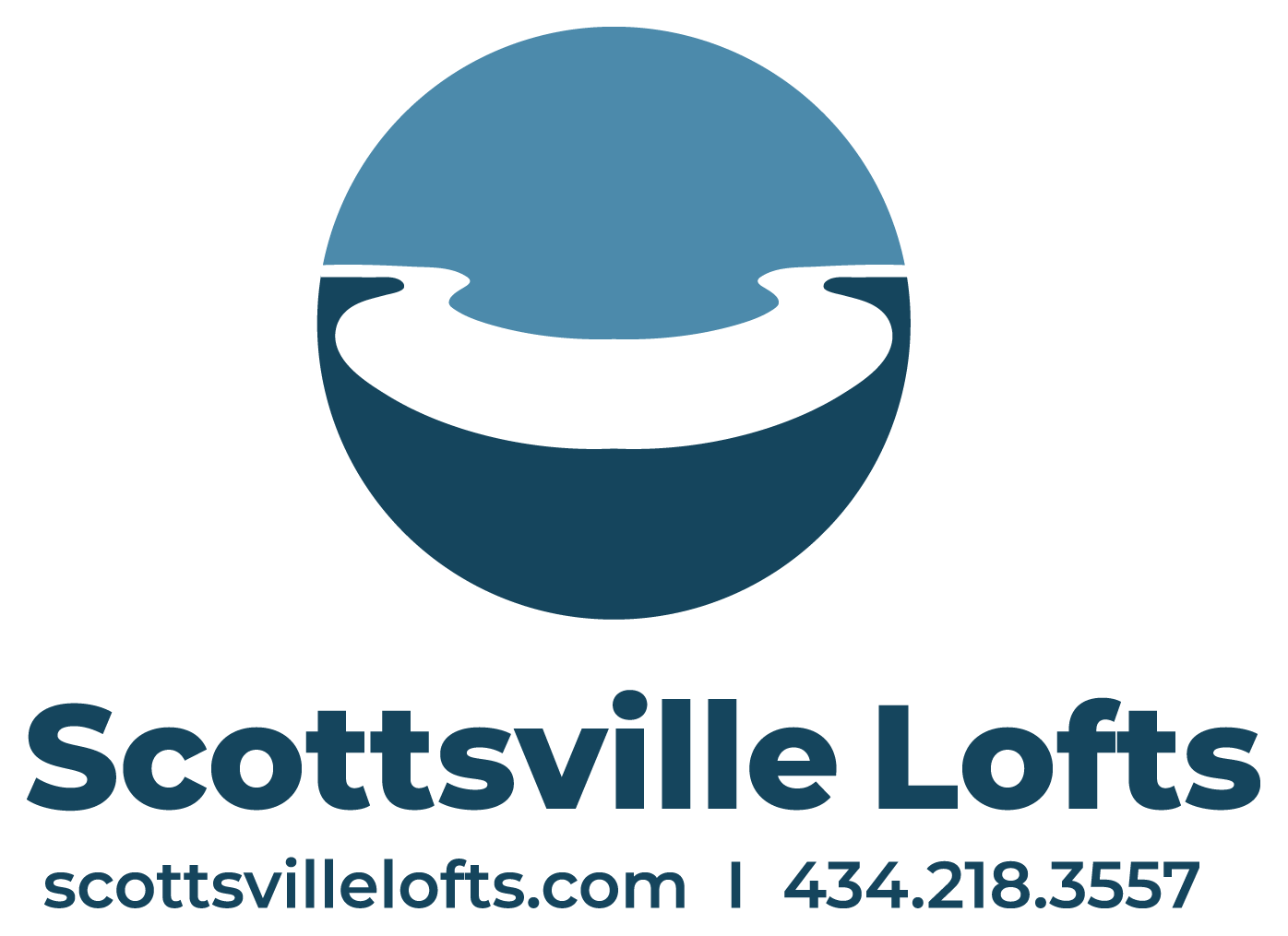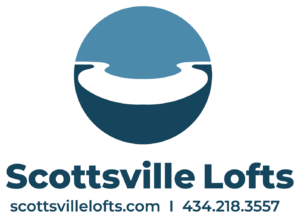Source: Scottsville Museum
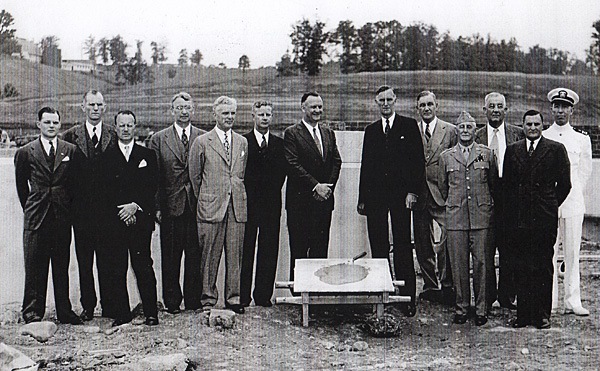
Name: Laying Cornerstone of Scottsville Plant
Date: May 24, 1944
Image Number: RT01cdRT02
Comments:
Scottsville Plant was built in 1944 by the Defense Plant Corporation to help the nation’s war effort. It was designed and constructed to provide tire fabric and was operated by the Textile Division of the U.S. Rubber Company. The cornerstone-laying ceremony for this plant was sponsored by the Scottsville Lions Club and attended by the Governor of Virginia, the U.S. Senator from Virginia, Scottsville’s Mayor, a Brigadier-General of the U.S. Army, a U.S. Navy Lieutenant Commander, Vice-President of the U.S. Rubber Company, and the Chairman of the Central Virginia Planning Committee. Shown above are some of the ceremony participants that proud day on May 24, 1944 (L to R):
1) unknown
2) unknown
3) H.E. Humphreys, Jr., Vice President, United States Rubber Company
4) unknown
5) unknown
6) O. L. Ward, Plant Manager, United States Rubber Company
7) Colgate W. Darden, Jr., Governor of Virginia
8) C. T. O’Neill, Chairman, Central Virginia Planning Commission
9) John S. Battle, State Senator, Virginia
10) Brigadier General E.R. W. McCabe, U.S. Army
11) Dr. Percy Harris, Mayor of Scottsville, Virginia
12) unknown
13) Lt. Commander S. F. Chase, U.S. Navy
The Scottsville Plant is located on 51 acres in Albemarle County, Virginia, in the town of Scottsville. Following are several photos of the plant under construction in 1944:
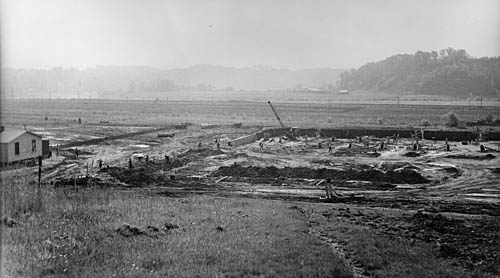
Excavation at the U.S. Rubber Plant began in 1944 at a site just west of Scottsville.
This photo was taken circa April 1944, looking southward at the plant site with the
James River in the background.

The Scottsville Plant produced rayon tire cord required in the heavy duty tires used by our military vehicles in WWII. Shown below is a small part of the large production room of the Scottsville plant:
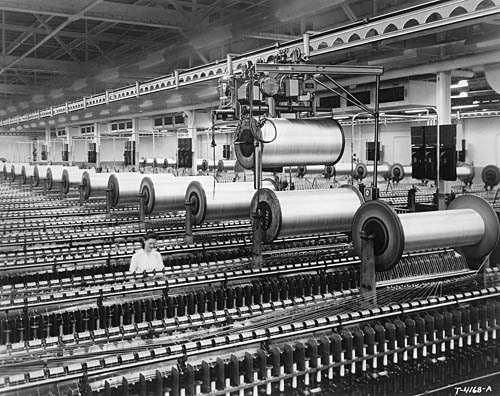
At the end of WWII in 1945, Uniroyal purchased the plant from the U.S. Government, and the Scottsville Plant officially joined Uniroyal. Uniroyal operated the plant as a manufacturing and supply unit to the tire industry, one of the largest industries in the world. The plant, in its history, has produced Rayon (a cellulose by-product) for tires and, with the advent of synthetics, has produced Nylon and Polyester tire cord fabric and Fiberglas fabric.
Over the years little change could be detected in the outside appearance of the plant, although machinery and equipment were constantly being changed and modernized. However in 1958, the skyline began to change as the new building for treating tire fabric was under construction. By the end of 1959, operations were underway in Scottsville’s new Hot Stretch Treating unit.
Since the 1959 addition of the Treating unit, the plant has benefitted from periodic expansion and modernization programs. In 1968, the Weaving Department was enlarged and the entire plant was air-conditioned. In 1973, a warehouse expansion doubled Scottsville’s capacity to store finished goods. The Hot Stretch machine was modified in 1983 to run double dip polyester fabrics. In 1984, the Treating unit was further modernized by modifying the ovens and tension controls to meet the more critical uniformity demands of monoply fabrics. The respooler operation was phased out over three years beginning in 1987. Ply Twisters were modified to run larger packages, which eliminated the need to respool ply bobbins, resulting in quality and cost improvements.
The peak employment period for Uniroyal’s Scottsville Plant was in the late 1960’s and early 1970’s. At that time, the plant employed 340 people and operated four shifts, five days a week. In the 1980’s, the plant operated on a steady five-day per week basis.
By the late 1950’s, the Scottsville Plant was well established with several smaller independent tire makers, as well as continuing to supply Uniroyal Tire plants. In 1972, the plant began production for The People’s Republic of China, beginning a relationship that continued through the years. The customer list constantly expanded to include clients on five continents. In August of 1986, the Scottsville Plant became part of the joint venture between Uniroyal, Inc., and the B.F. Goodrich Company, which operated as the Uniroyal Goodrich Tire Company (UGTC).
In May of 1990, UGTC was purchased by The Michelin Groupe, and with this purchase the Scottsville Plant’s mission changed. The plant was then dedicated to supplying the needs of Uniroyal Goodrich and Michelin tire plants. In 2002, Michelin’s textile plant in Scottsville was sold for $7-million to Hyosung America, Inc., an affiliate of Hyosung Corporation of Korea. Under the terms of the agreement, Hyosung offered employment to all 240 Scottsville employees and also planned to update the plant.
In November 2009, the Hyosung plant manager, Roger Hutchins, advised the 106 remaining plant employees that the Scottsville plant would shut down by the end of January 2010. Mr. Hutchins said that the slumping economy and pressure from global manufacturers cut into their ability to make a profit building tire cords.
The top photo is part of the Raymon Thacker Collection at Scottsville Museum. The remaining four photos are part of the Hyosung America, Inc.,Collection at the Museum.
Copyright © 2018 by Scottsville Museum
Redevelopment
The story of the to-be-renovated Scottsville Lofts began mid-last century! This historic site has been integral to the growth and identity of the Town of Scottsville since its construction. Through much planning and creative thinking (and hard work!) the site and buildings will be renovated into rental housing, to be known as Scottsville Lofts. The parking and grounds will be revamped. The historic features will be preserved and highlighted as this project utilized federal and state historic rehabilitation tax credits, so the redevelopment design will be overseen by both the Virginia Department of Historic Resources and the federal National Park Service, and executed by the experienced historic property development team of Echelon Resources. These upscale apartments maintain many of their original historic features while offering polished concrete and hardwood floors, all-new appliances and systems, high ceilings, beautiful cabinets…and many other amazing features in this pet-friendly community. Come tour your next apartment home!
Project Timeline
- Summer/Fall 2018 | Initial tours of site, meetings with property owner
- February 2019 | Town leaders introduced to Developer, site tour
- Spring/Summer 2019 | Dialogue with Town/County regarding utility infrastructure
- June 2019 | Waukeshaw Development selected for site feasibility study, Developer withdraws from site consideration
- June 2021 | Developer tours similar factory building (already redeveloped) in South Richmond, sees design approach that might work at site
- Summer 2021 | Developer re-enaged with Town leaders with new design approach
- September 2021 | Town leaders tour Developer properties in other parts of Virginia
- Fall 2021 | Developer worked with Town leadership on a floodplain ordinance update
- Fall 2021 | Town awarded a $123,000 flood prevention and protection/floodplain management grant from Virgina Department of Conservation and Recreation
- March 2022 | Town awarded $75,000 from the Virginia Department of Housing and Community Development as a planning grant from the Industrial Revitalization Fund
- May 2022 | Developer teams up with Southern Development principals via subsidiary to redevelop site
- June 2022 | Town leadership meeting
- July 2022 | Development partnership formalized and site control secured
- August 2022 | Rezoning request submitted (SUP from Industrial to Commercial w/Multi-family)
- September 2022 | Town awarded $55,000 from Virginia Housing as a Community Improvement Grant
- October 3, 2022 | Planning Commission Public Hearing
- November 7, 2022 | Planning Commission approves zoning application
- November 14, 2022 | Town Council meeting
- November 15, 2022 | Virginia Department of Historic Resources staff, Developer, and projecct architect tour site to brainstorm design solutions and historic tax credit program guidance.
- December 12, 2022 | Town Council special meeting
- January 12,72023| Town Council rejects zoning application
- March 2023 | Project site PIF unanimously approved by the Virginia State Review Board. The project now can move forward with the formal National Register Nomination.
